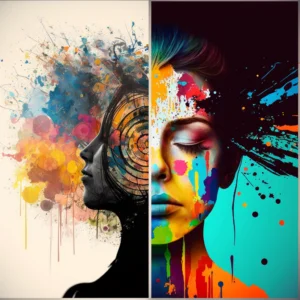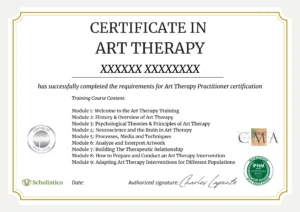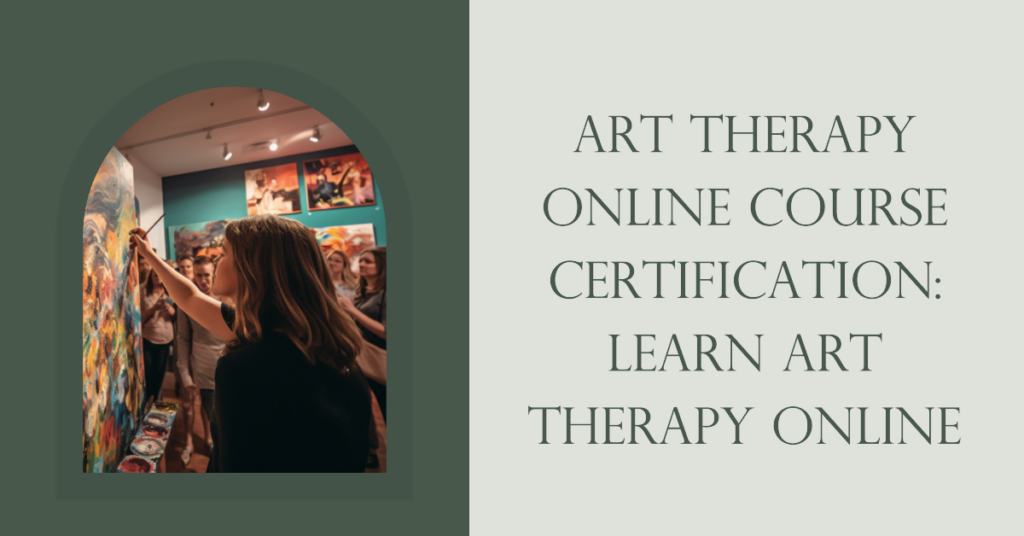Art Therapy Certification and Licensing: What You Should Know

If you’re considering formal art therapy training, such as obtaining a master’s degree and relevant licenses or certifications, you might be unsure of the specific credentials you need. The answer depends on various factors like your state of residence, the regulations in place, and whether you want to do clinical or non-clinical work.
To help you navigate this complex topic, we’ve outlined four different scenarios for individuals in the United States seeking to practice art therapy. Please note that this information is not legal advice, and you should consult a legal professional for specific guidance.
Types of Credentials
Before diving into the scenarios, it’s essential to understand the two main types of credentials available to art therapists:
Registration / Board Certification (ATR or ATR-BC): This credential is awarded by the Art Therapy Credentials Board and signifies that the individual has completed the required master’s degree and post-graduate supervised hours to be a qualified art therapist. Board Certification is obtained by passing an exam.
License (LCAT, LPC-AT, LCAT, LCPAT, LPCC, LPC, LCPC, LMFT, LCSW, etc.): Each state has a different name for its art therapist license, or it might classify them under counselor or marriage & family therapist licenses. This is an official state license to provide mental health treatment. Some states do not have a specific license for art therapists.
Scenario 1: You’re In A State With Art Therapist License Or Title Protection
If your state has an art therapist license or title protection, you must obtain the appropriate license (e.g., LPCC, LCPC, LPC, LMFT) to practice art therapy or be hired as an art therapist. Check your state’s board or the American Art Therapy Association (AATA) website for updates on regulations.
Scenario 2: You’re In A State Without License
If your state doesn’t have an art therapist license or title protection, you can obtain an ATR-BC or a related certification like REAT. This credential will allow you to provide strictly “art therapy” services, but not psychotherapy.
Scenario 3: You Want To Do Clinical Work
If you want to do clinical art therapy work, you’ll need another license (or degree) to practice. This could be an art therapist license or a different mental health provider license, like counselor or marriage and family therapist license. The specific license you should pursue depends on your desired area of study and the types of positions you want to be considered for.
Scenario 4: You Want To Do Non-Clinical Work
If you prefer non-clinical work, you may not need a license or certification, as you won’t be providing psychotherapy services. You can still help people with their well-being through art, but you can’t “treat” mental health diagnoses or illnesses. You can obtain credentials like ATR or ATR-BC or complete shorter trainings for this type of work.
Bonus Section: Art Therapy Certification and Licensing in Canada
In Canada, art therapy training and licensing are regulated at the provincial level. Here are the general guidelines for becoming an art therapist in Canada:
- Education: Obtain a master’s degree in art therapy from an accredited institution or a program recognized by the Canadian Art Therapy Association (CATA). Some institutions offer combined bachelor’s and master’s programs, which can save time and resources.
- Certification: After completing your education, apply for professional membership with the Canadian Art Therapy Association (CATA). Becoming a CATA member signifies that you have met the required educational and practical experience standards.
- Provincial Licensing: Depending on the province you plan to practice in, you may need additional licenses or certifications, such as a counseling or psychotherapy license. Be sure to research the specific requirements for the province where you intend to work.
Bonus Section: Art Therapy Certification and Licensing in Australia
In Australia, the Australian, New Zealand, and Asian Creative Arts Therapies Association (ANZACATA) is the main professional body for art therapists. Here are the steps to becoming an art therapist in Australia:
- Education: Complete a master’s degree in art therapy from an accredited institution or a program recognized by ANZACATA. Some universities also offer postgraduate diploma programs, which can be an alternative pathway into the profession.
- Registration: After completing your education, apply for professional membership with ANZACATA. This membership demonstrates that you have met the required educational and practical experience standards.
- State Licensing: There isn’t a specific license for art therapists in Australia. However, you may need to register with the relevant state or territory body if you plan to provide mental health services. Research the specific requirements for the state or territory where you want to practice.
Bonus Section: Art Therapy Certification and Licensing in the United Kingdom (UK)
In the United Kingdom, the British Association of Art Therapists (BAAT) is the main professional organization for art therapists. Here are the steps to becoming an art therapist in the UK:
- Education: Complete a master’s degree in art therapy or art psychotherapy from a program approved by the Health and Care Professions Council (HCPC). This is the regulatory body for health and care professionals in the UK.
- Registration: After completing your education, apply for registration with the Health and Care Professions Council (HCPC). Registration is required to legally practice as an art therapist or art psychotherapist in the UK.
- Professional Membership: You may also consider joining the British Association of Art Therapists (BAAT), which provides additional resources, networking opportunities, and support for art therapists.
Bonus Section: Art Therapy Certification and Licensing in Germany
In Germany, art therapy is recognized as a profession within the field of psychotherapy. Here are the steps to becoming an art therapist in Germany:
- Education: Complete a master’s degree in art therapy from an accredited institution or a program recognized by the German Professional Association for Art Therapy (DGKT) or the Federal Association of Art Therapy (BAG KT).
- Certification: After completing your education, you may apply for certification with the DGKT or the BAG KT, which signifies that you have met the required educational and practical experience standards.
- Psychotherapy License: If you plan to provide psychotherapy services in Germany, you’ll need to obtain a license as a psychological psychotherapist (Psychologische Psychotherapeutin) or a child and adolescent psychotherapist (Kinder- und Jugendlichenpsychotherapeutin). This requires additional education and training in psychotherapy.
Art Therapy Certification and Licensing in Italy
In Italy, art therapy is a growing field, and there is no specific national regulation for the profession. However, several professional associations and institutions offer education, training, and recognition for art therapists. Here are the general guidelines for becoming an art therapist in Italy:
- Education: Complete a master’s degree in art therapy or a related field from an accredited institution or a program recognized by an Italian professional association, such as the Italian Art Therapy Association (AIART) or the Italian Society of Art Therapy (SIPEA).
- Membership: After completing your education, consider applying for membership with an Italian art therapy association like AIART or SIPEA. These associations provide resources, networking opportunities, and support for art therapists in Italy.
- Additional Certification: In Italy, art therapists may also choose to pursue additional certifications or training in psychotherapy, which may be required to provide psychotherapy services.
Bonus Section: Art Therapy Certification and Licensing in the Netherlands
In the Netherlands, art therapy is recognized as a creative therapy profession. Here are the steps to becoming an art therapist in the Netherlands:
- Education: Complete a bachelor’s degree in creative therapy or art therapy from an accredited institution or a program recognized by the Dutch Association of Art Therapists (NVBT), which is a part of the Federation of Arts Therapists (FVB).
- Registration: After completing your education, apply for registration with the Register for Arts Therapists (SRVB). This registration demonstrates that you have met the required educational and practical experience standards.
- Professional Membership: You may also consider joining the Dutch Association of Art Therapists (NVBT) or the Federation of Arts Therapists (FVB) for additional resources, networking opportunities, and support for art therapists in the Netherlands.
It’s essential to consult the appropriate organizations and legal professionals in each country for specific guidance on art therapy certification and licensing. While these bonus sections provide an overview of the requirements in the United Kingdom, Germany, Italy, and the Netherlands, it’s crucial to understand that regulations can change, and you should always stay up-to-date with the latest information from the relevant authorities. By familiarizing yourself with the regulations in your country of interest, you can better prepare for a successful career as an art therapist, helping individuals find healing and personal growth through creative expression.
Making the Decision Easier
To make the decision-making process easier, consider your goals, such as the types of clients you want to work with, where you want to work, and whether you want to start your own business. If you’re unsure, gain experience, explore your interests, and consult with art therapists to gain perspective.
Learn More with Our Art Therapy Course
We hope this blog post has provided valuable insights into the world of art therapy certification and licensing. If you’re interested in deepening your understanding and building a career in this field, consider enrolling in our comprehensive art therapy course. This course will equip you with the knowledge and skills needed to provide art therapy services effectively, whether in a clinical or non-clinical setting.
By participating in our art therapy course, you’ll join a vibrant community of learners and professionals passionate about helping others find healing, peace, and joy through art. Don’t miss out on this opportunity to expand your horizons and make a difference in people’s lives. Click here to learn more about our art therapy course and sign up today!
Good luck on your journey, and don’t forget to share this blog post with friends or colleagues who might benefit from this information!












Responses